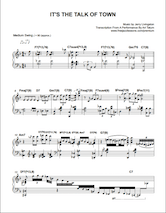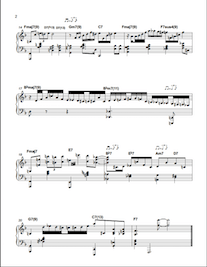Art Tatum Piano Exercises: Killer Piano Shred Lesson
 Would you like to learn some Art Tatum piano exercises? You’re in the right place.
Would you like to learn some Art Tatum piano exercises? You’re in the right place.
In the lesson below, you’ll discover some Art Tatum piano exercises I created from a transcription of “It’s The Talk Of The Town”.
This transcription will help you learn how to play jazz piano like Art Tatum.
These piano exercises will help you build your jazz piano composition chops and jazz improvisation chops.
Take at least 1 minute to listen to Art Tatum’s performance. We’ll break down the 1st 21 bars below.
Art Tatum Piano Performance Of “It’s The Talk Of The Town”
5 Tips To Learn How To Shred With Art Tatum Piano Exercises
Now that you’ve taken a minute to listen to that recording, let’s go further into Art Tatum piano exercises from that performance.
1. How To Play “It’s The Talk Of The Town” Like Art Tatum
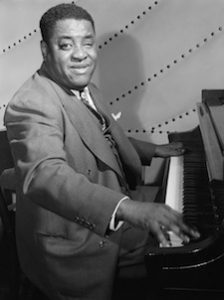 1 way to learn jazz piano is to transcribe recordings note for note and then imitate.
1 way to learn jazz piano is to transcribe recordings note for note and then imitate.
Now, I realize this can be a very time-consuming task. So, I’ve actually done an Art Tatum piano transcription for you.
All you need to do is download is download the jazz piano sheet music pdf below:
—–<Download “It’s The Talk Of The Town” Transcription Here>—–
Once you have downloaded the piano sheet music pdf, here’s how you start learning the first 50 seconds of the recording:
- Listen to the recording while reading the sheet music.
- Learn 1 to 4 bars at a time (approximately 1 phrase), hands separate at first then hands together.
- Learn the transcription at a slow tempo.
- After sufficient mastery, practice alongside the recording hands separate at first then hands together.
After you’ve gone through the music a few times, we can start picking out various Art Tatum piano exercises from it.
2. How To Play Art Tatum Chord Voicings
Ok lets get into a lot of the jazz piano chords that Art Tatum uses now.
The 1st 4 bars provide insight into how Art Tatum plays two-handed chord voicings:

A number of these chords are rootless jazz voicings.
In the first bar, we see a rootless F7(b13,b9) voicing where the left hand plays Gb(b9) and Eb(b7). The right hand plays a major 3rd (A), b13(B natural), and another b7 an octave up.
We have another variant of a dominant 7th sus4 chord on the 2nd bar.
The left hand plays the perfect 4th, b7, and a 9th. The right hand has your b13(a G#) and the 3rd.
The last bar of the intro is the first time we see chords with a root: a Gm7b5 and a C7 with a 9th.
How To Learn More Chords From Art Tatum’s Voicings
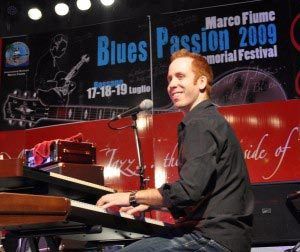 You need to learn the chord voicings in all 12 keys.
You need to learn the chord voicings in all 12 keys.
The fastest way to do this is to play the intro first in the original key and then transpose it up a half step.
Keep on moving those chord voicings a half step up until you can play them in all 12 keys.
After that, try using those chords in other tunes.
Want to learn more chord voicings like these? Premium Jazz Lessons has a dedicated chords library that makes learning easy. Get instant access to Premium Jazz Lessons here.
Now that you know some Art Tatum chord voicings, let’s learn how he adds flash to jazz piano solos.
3. Why The Dominant 7th(b13) Is Awesome For Two-Handed Piano Runs
 Art Tatum is known for his fast piano runs.
Art Tatum is known for his fast piano runs.
Fast runs can be intimidating to learn at first.
However, we can break it down to bits that are simple enough to understand.
Here’s one run that Art Tatum uses over Db7 chord:

This run right here is based on a G7(b13) chord, also known as a Gaug7 chord.
It’s a crazy fast run in the recording.
There are a couple of things you need to understand how to pull this one off:
- The run only consists of 4 notes being repeated all over (G, B, Eb, F).
- You can play the run using both hands: 2 notes on the right hand (Eb, B) and 2 notes on the left (G, F). Just use fingers 1 & 2 of each hand.
- Practice the run real slow at first, then gradually speed it up as you get used to it.
Once you have learned how to play this jazz piano run, it’s time to make it your own.
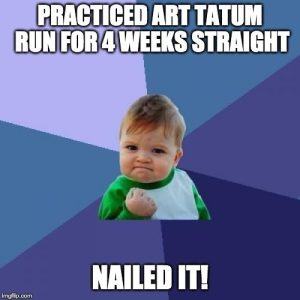 The good thing about this dominant 7th (b13) run is that:
The good thing about this dominant 7th (b13) run is that:
- It can be used on a variety of dominant 7th chords. This G7(b13) run can be used over G7, Db7 (tritone substitute of G7), and Eb7.
- Because it can be used over 3 dominant 7th chords, you can use it to change to 3 different keys.
- It’s a powerful way of making a musical statement before resolving to the I chord.
- That augmented 5th sound adds so much tension that really itches for a resolution. It’s basically just a jazz arpeggio.
- When mastered, it’s really fun to play.
How To Go Further With Art Tatum Piano Runs
 Here’s another interesting bit:
Here’s another interesting bit:
If you break the G7(b13) chord, you actually get a G (G and B) on one hand, and an Eb with a 9th (Eb, F, G) on another hand.
And so, all you have to think about when transposing the dominant 7th (b13) shape is that minor 6th relationship (G to Eb are a minor 6th apart).
Because of the notes available, this dominant 7th (b13) shape can function as either G7 or Eb7. This gives you plenty of options to change keys.
Here are some examples:
- If the run functions as a G7, you can resolve to the key of C/Cm (V to I or i movement) or Gb/F#m (G7 as a tritone substitute of Db7 or C#7).
- If the run functions as an Eb7, resolutions are to key of Ab/G#m (V to I or i) or D/Dm (Eb7 as a triton substitute of A7).
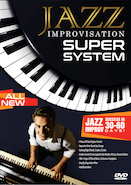 Therefore, the augmented 7th arpeggio run by Art Tatum is really handy for solos and jazz improvisation.
Therefore, the augmented 7th arpeggio run by Art Tatum is really handy for solos and jazz improvisation.
If you want to take your soloing skills to even greater heights, check out the Jazz Improvisation Super System.
This course reveals David Garfield’s trick for playing confidently over fast chord changes.
Get instant access to the Jazz Improvisation Super System here.
Now that we’ve talked about arranging, how can you sound as full as Art Tatum? Find out below.
4. How To Sound Like A Full Ensemble On The Piano
 Art Tatum’s playing is very similar to Franz Liszt’s orchestral approach.
Art Tatum’s playing is very similar to Franz Liszt’s orchestral approach.
In big band and orchestra performances, there are tuttis (all instruments playing together) and solos.
When you review the sheet music, you’ll notice that Art Tatum emulates a big band performance.
Let’s examine some sections of the transcription to see how Art Tatum does it:
- Bar 6 features a typical right-hand melody with left-hand jazz comping. The first 2 beats implies a homophonic texture while the next 2 beats feature some counterpoint:
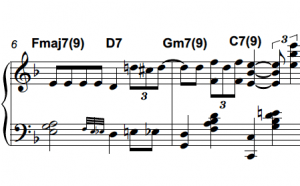
- Bar 7 now has Art Tatum’s trademark stride piano technique that simulates drums, bass, and the lower pitched instruments of the big band. The right-hand octaves and chords simulate tutti of higher pitched instruments.
- Bar 8 and 9 feature the same patterns described in 1 & 2:
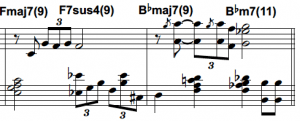
- Bar 10 features a thick texture with bass on the 1st beat, thick left-hand chords from beats 2 to 4, and a melody in octaves.
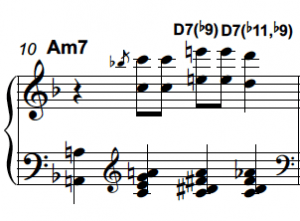
- Bars 11 to 12 feature that stride piano pattern for the left hand. The right hand plays a melody and then chords in the inner voice.
 On the G7 chord in bar 12, the left hand plays a typical stride piano pattern while the right hand plays chromatic turns right before hitting chords. This extends to bar 13 just before playing a single line run:
On the G7 chord in bar 12, the left hand plays a typical stride piano pattern while the right hand plays chromatic turns right before hitting chords. This extends to bar 13 just before playing a single line run: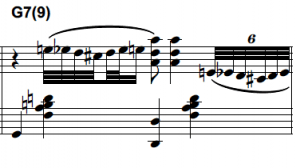
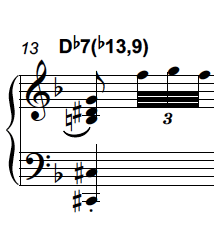
- Bar 13 features that augmented 7th arpeggio run that we talked about earlier. This emulates a single instrument taking a solo in an ensemble context:

Using such variations in texture makes any Art Tatum piano performance interesting and engaging.
Since we have mentioned variations, let’s talk about another device that he uses to create variety.
5. How To Use Chromatics Like Art Tatum
 Art Tatum is fond of using chromatic ornaments and passages.
Art Tatum is fond of using chromatic ornaments and passages.
As the name implies, chromatics add a lot of color to otherwise plain scale and arpeggio runs.
Here’s one lick that you can use over a ii – V – I chord progression that highlights chromatics:

While we have more of a backdoor chord progression going on here (Bbmaj7 – Bbm7 – C7), the actual lick outlines Dm7 – Gaug7 – C.
Just after the 1st beat of this bar, we have a Dm7 arpeggio followed by chromatic ornaments:
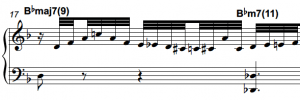
At the “&” of beat 3, we have a descending Gsus4 arpeggio followed by a chromatic passage that resolves to an E (works either as the major 7th of F or the 3rd of a C).
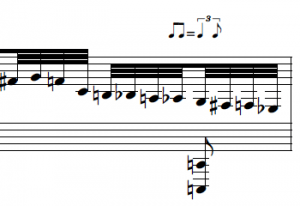
To integrate this into your own playing, practice this lick in the original key then in all other keys.
This way, the lick becomes part of your soloing vocabulary.
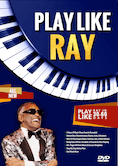 Another legend to check out how to play full-sounding arrangements across many genres is Ray Charles.
Another legend to check out how to play full-sounding arrangements across many genres is Ray Charles.
You can learn plenty or Ray’s arranging techniques in Play Like Ray.
Play Like Ray features note-for-note transcriptions of Ray’s piano parts you can use to quickly add hundreds of playing techniques under your fingers.
Start learning how to Play Like Ray here.
Now that we’ve discussed Art Tatum piano techniques, how do you use all of them effectively? Let’s talk about some of the challenges and opportunities you have for growth below.
What You Should Know About Jazz Piano Techniques
 Obviously if you’ve read this far into the article you’d like to move your fingers like Art Tatum. I mean he was a piano genius!
Obviously if you’ve read this far into the article you’d like to move your fingers like Art Tatum. I mean he was a piano genius!
But, most people get lost in a sea of technical exercises.
You can be the most disciplined musician out there and run circles around anyone else. However, your performance ends up uninspiring because you can’t use your techniques properly.
Worse, your performance may end up so uninteresting that you get no reaction from your audience.
If you feel like you’re just spinning your wheels in the practice room. There’s fantastic new.
The Jazz Inner Circle gives you the opportunity to work 1-on-1 with world-class jazz piano instructors. By learning from true jazz piano legends you can save 1000’s of hours in the practice room and start playing music that impresses.
 All of our instructors have years of gigging and touring experience so they know exactly what it takes to succeed on the biggest stages in the world.
All of our instructors have years of gigging and touring experience so they know exactly what it takes to succeed on the biggest stages in the world.
Even if you have very little jazz piano experience or cannot read standard notation, our Jazz Inner Circle instructors will help you become the musician of your dreams.
Inside the Jazz Inner Circle, you’ll discover:
- “The Jazz Piano Mastery Program” (Over $25,000 worth of jazz piano training resources, tools, practice templates, improv strategies, & tons more.)
- “The Ultimate Jazz Workout Training System.” This is where we implement a complete practice program to build your jazz piano talent in record time.
You can apply for the Jazz Inner Circle right here —> https://www.freejazzlessons.com/inner-circle
Enjoy learning Art Tatum piano exercises. If you enjoyed the lesson or would to share thoughts and additional ideas, please feel free to leave a comment below.
As always, we’re always here to help you become a better musician. Have fun practicing!

